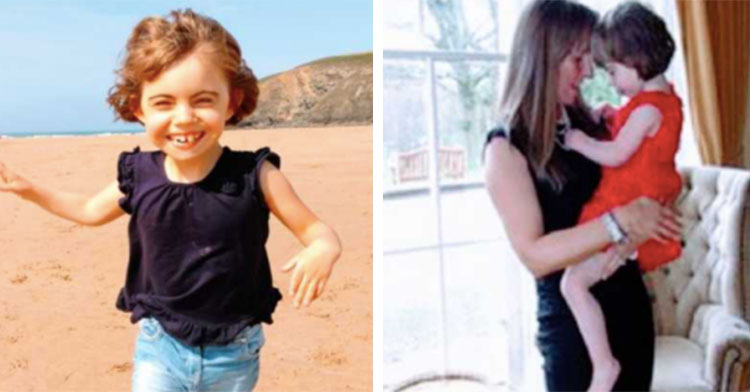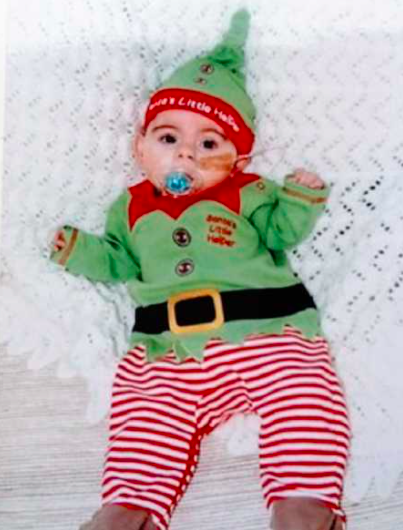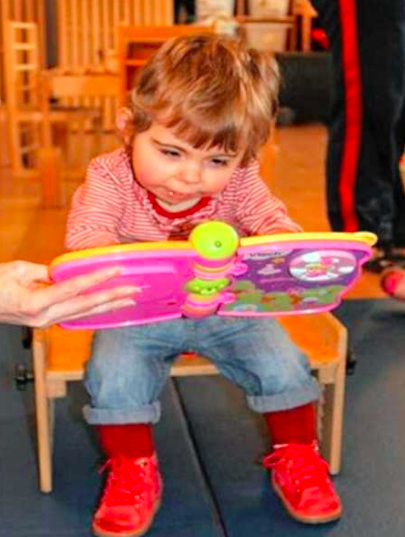Get more stories like this in your inbox! Sign up for Smile, our free daily good news email read by over 825K people!
Videos by InspireMore
“Hannah is almost 12 years old. She’s inquisitive and full of fun and mischief, and she lights up a room with her smile. Hannah embraces life like no one I’ve ever known. She LOVES broccoli. She has lots of interests including a fascination with shoes. She’s a very active child too (that’s a bit of an understatement!), and my goodness, she may be tiny, but she is STRONG!
But seemingly, Hannah’s life wasn’t destined to be an easy one.
Many moons ago, after some tests, we were advised it’d be ‘highly unlikely’ we’d ever have children. However, destiny seemed intent on overriding that medical opinion. It had other plans for us!
After hearing her heart beating then seeing her on the ultrasound, I knew I would love this child until my bones became dust. My girl; we would have so many adventures together, I was sure of it.
…and I wasn’t wrong!
There were no concerns during pregnancy and no indication whatsoever from the medical professionals as to what was to follow. In July 2009, our lives changed forever. Immediately after my tiny baby was born, it was found she had a cleft palate. Then, we were told there were 2 holes in her heart (which did, thankfully, spontaneously close), and she also had a heart defect that couldn’t ever be ‘fixed.’ I’d only just given birth, but my own heart was broken by this point. How could all this have happened?
We were told Hannah didn’t have a chin or gag reflex, so she had to be fed through a tube that went up her nose and into her tummy. I longed to take my baby home, just like all the other parents were doing. But after an emotional and challenging 3+ weeks in the hospital and a very insistent attitude for discharge on my part, we escaped the confines of the hospital and were finally able to take our baby home.
But it was scary. So scary. This fragile and precious little person needed so much help.
Countless tests and appointments followed, the lists of concerns increased, and there were many other things identified over time (and not the kind of things you want to hear as a new parent!) which suggested Hannah may be affected by a syndrome. Sure enough, after seeing a Professor of Genetics, Hannah was considered to have Cornelia de Lange Syndrome—also known as CdLS.
When I heard the diagnosis, I felt the room close in on me. I thought I’d never breathe out again, never laugh, never have fun. Was this our life now? What about all those dreams I’d had of how life was going to be? Why us? Why Hannah? But over time, I thought about it and came to the conclusion: why NOT us? Things like this had to happen to someone, didn’t they?
To be certain of the diagnosis, Hannah had blood taken, and then we waited for the results to determine whether there was a change on her NiPBL gene—the most typical gene change in individuals with CdLS. The test established there was no change to this gene, and so further testing had to be done.
We then waited 7 years for the results. A letter arrived confirming she did have Cornelia de Lange Syndrome. Because so much time had passed, I felt relieved a definitive diagnosis had been made. Some parents don’t want or need those answers, and I respect that, but I did because then we could see what challenges may lie ahead and try to make things a little easier. For me, knowledge is power.
Cornelia de Lange Syndrome is a very rare genetic condition and statistics of people affected range from around 1 in 10,000 to 1 in 30,000 babies born. Hannah is affected by a change on the SMC1A gene which lies on her X Chromosome. Only 5% of people affected by CdLS have this gene change, so she’s rarer than rare.
Before her first birthday, Hannah had surgery to repair her cleft palate. The surgery went well, however, she had a post-operative respiratory arrest, her lungs filled with blood, and her heart stopped. Life was being so cruel to her. As if she (and we) hadn’t been through enough already!
Her Daddy and I were in the room when it happened. We thought we were going to lose her. But, thankfully, she was resuscitated and after a stay in the High Dependency Unit and some time on the ward, we were allowed to go home again; still with a cleft palate as resuscitation had undone some of her cleft repair. But that was the least of our worries!
When Hannah was 2 years old, she couldn’t even sit up on her own. While there were lots of professionals involved in monitoring her, very few were doing anything to make any positive change. I was desperate for help and so I reached out to a charity providing Conductive Education to children and young people. With their support and Hannah’s tenacity, time, practice, and lots of patience, she learned to sit independently.
On Christmas Day, when Hannah was almost three and a half years old, she took her first wobbly steps. I cried. It was the most magical day ever—the best Christmas present I could have ever wished for. All the money in the world can’t buy you that feeling. My girl, my precious girl, had worked so hard to get to this point.
If I could go back in time and change a few things, I’d tell myself not to get as upset at all the speculative comments made by medical professionals regarding Hannah’s future (those comments weren’t grounded in any evidence!) and not to trawl the internet when Hannah was first born—reading all those scary research papers about what my baby might NOT be able to do in the future. And literally, that’s all I did: scare myself and break my heart in equal measures.
So, here we are, almost 12 years later. And SO much has happened! Our life is very different from the one we’d originally anticipated. However, I’d say, in many ways, it’s far more enriching. Hannah’s unwittingly been the greatest teacher of life anyone could ever wish for—the fragility of it and the beauty too. She’s taught me SO many things—not to take life for granted, to be brave, to be tenacious…and SO much more.
Hannah’s currently non-verbal (although she has said a few words), and I still long to hear her say ‘mommy.’ She also experiences a range of other challenges like skeletal changes, self-injurious behaviors, and difficulties with sensory processing and the way she sees the world. Hannah also received a formal diagnosis of Autism a few years ago. She has a whole list of challenges—far too many to mention here.
Hannah doesn’t know her own limitations and has no concept of her and others’ safety, so we have to be on our toes and be vigilant, constantly! However, she can often make her needs known (not always though, unfortunately), she can also get into scrapes, be lazy and stubborn and cheeky, and sometimes be naughty too—JUST like any other child (and grown-up) you may know. And she has a fantastic sense of humor.
CdLS affects most aspects of Hannah’s life, but we live with CdLS, and it doesn’t stop us from trying to do new things. Have you met anyone else who’s been on a zip wire, been in magazines and newspapers and been read about by people all over the world, won awards, taken an alpaca for a walk, been canoeing, met a plethora of celebrities, been a football mascot, inspired people to walk 500 miles or run marathons…or even tried to flick Spiderman’s eyes off (long story)? I’ve not. Have you?
But Hannah’s done all these things and more. It’s just a matter of learning to look at life through a different lens, making adaptations, and embracing opportunities or seeking them out.
I’ll be honest, I was devastated when Hannah was first diagnosed with CdLS. I thought both our lives—now so inextricably linked—were over. But the day after diagnosis, I reached out to the CdLS UK and Ireland Foundation, and they’ve been there for us ever since.
Life with a child who has a condition like CdLS has its challenges, and it can leave you feeling very isolated—not even people you’d expect to understand, do. So you have to find your Tribe. And we’ve found them—the Foundation and the other families who live all over the world whose lives are touched by CdLS. They are our extended family. They get it. Completely.
When life settled down a little, I began writing a blog, My Kid Loves Broccoli, so people just starting out on their own journey, could read about LIFE post-diagnosis. I wanted to dispel a myth and make evident that kids, no matter what their disabilities, are kids, REGARDLESS of having additional needs, but they may often experience significantly more challenges in their lives than an average child.
In addition, I wanted to spread the word about CdLS as, when Hannah was diagnosed, there was very little on the internet which showed there CAN be life after diagnosis. It scared me reading all those research papers in the early days about what the future might hold, and I wanted to alleviate a little of those angsts parents with children newly diagnosed may have. I’m absolutely delighted when people across the world contact me when starting out on their own journey post-diagnosis and feel somewhat relieved they’ve come across what I’ve written.
I also wanted somewhere to rant. Because let’s face it, we ALL need a rant sometimes…but probably more so if you’re a parent to a child with additional challenges. Not everyone—even family and friends—will ever ‘get’ your life and the challenges and stresses you and your child face or even be interested in doing so, so you need to find your Tribe. Your people, the people who WILL ‘get it,’ completely, or who are willing to know more, regardless of where they are in the world. And the internet is often a good starting point.
And I also wanted somewhere to document and celebrate what Hannah COULD do, because, often, especially in those early years, it feels like the focus is only on what your child CAN’T do…and as Hannah’s mommy, that hurt. It hurt a lot. It also got very tiring and, to be honest, quite boring!
There are lots of reasons why I wanted to write—it can be very cathartic—and I’m SO glad I did. I could never have imagined where it would take us, who we would meet along the way, and how many thousands of people it’s reached all across the globe.
And those people who have joined us on social media are also now part of our Tribe. They help me help Hannah have a voice. And as time goes on, her voice gets louder and more people will get to know about CdLS and Autism and some of the experiences children with additional needs and their parents may face.
Leonardo Da Vici once said, ‘All our knowledge has its origins in our perceptions.’ So if we can help shift just a few people’s perceptions (which are often misconceptions) of special educational needs and disability through sharing some aspects of our life, that can only be a good thing, right?
By sharing aspects of our life I also wanted to show we’re human. We’re not saints or superheroes (although I’d say my child is my superhero), we’re simply parents destined for a different, much less average life. We make mistakes. We feel sad, scared, happy, excited, delighted. We ride the rollercoaster, we navigate the ship without a compass. We fall down, but we get back up. We fight, and we push for services and change. We do all of this and much, much more because we love our children and would do anything for them. I am her voice, her advocate, her cheerleader. She is my inspiration.
I’ve also had a book published—called The Little Book of Broccoli—doodles and stuff about our rare journey. And I’m currently trying to finish The Big Book of Broccoli—the one that ought to have been published prior to the Little Book. However, when I gave up my career to complete the book, I didn’t anticipate becoming a 24/7 mommy/therapist/nurse/entertainer/teacher (amongst many other roles) for the next six months during a global pandemic. Hannah takes priority above all things, and rightly so. Nevertheless, I’m hoping to have the book published by the end of 2021—life permitting!
Yes, there are challenges. Life is very tough sometimes…and scary too. I once grieved for a life I wished for but will never have. I fear leaving my precious and vulnerable girl in a world that isn’t accepting and compassionate towards people with differences. However, I can honestly say life is far more colorful now and the world is a far better place with Hannah in it. People could learn a lot from her if only they took the time to notice.
CdLS Awareness Day is observed annually (and globally) on the second Saturday of May. So it’s our opportunity to shine a light on this little-known condition that rarely gets any mainstream attention.â€
This story was submitted to Love What Matters by Anne and her daughter, Hannah, of England. You can follow their journey on Facebook, Instagram, and their blog.
Get more stories like this in your inbox! Sign up for Smile, our free daily good news email read by over 825K people!
Want to be happier in just 5 minutes a day? Sign up for Morning Smile and join over 455,000+ people who start each day with good news.

















